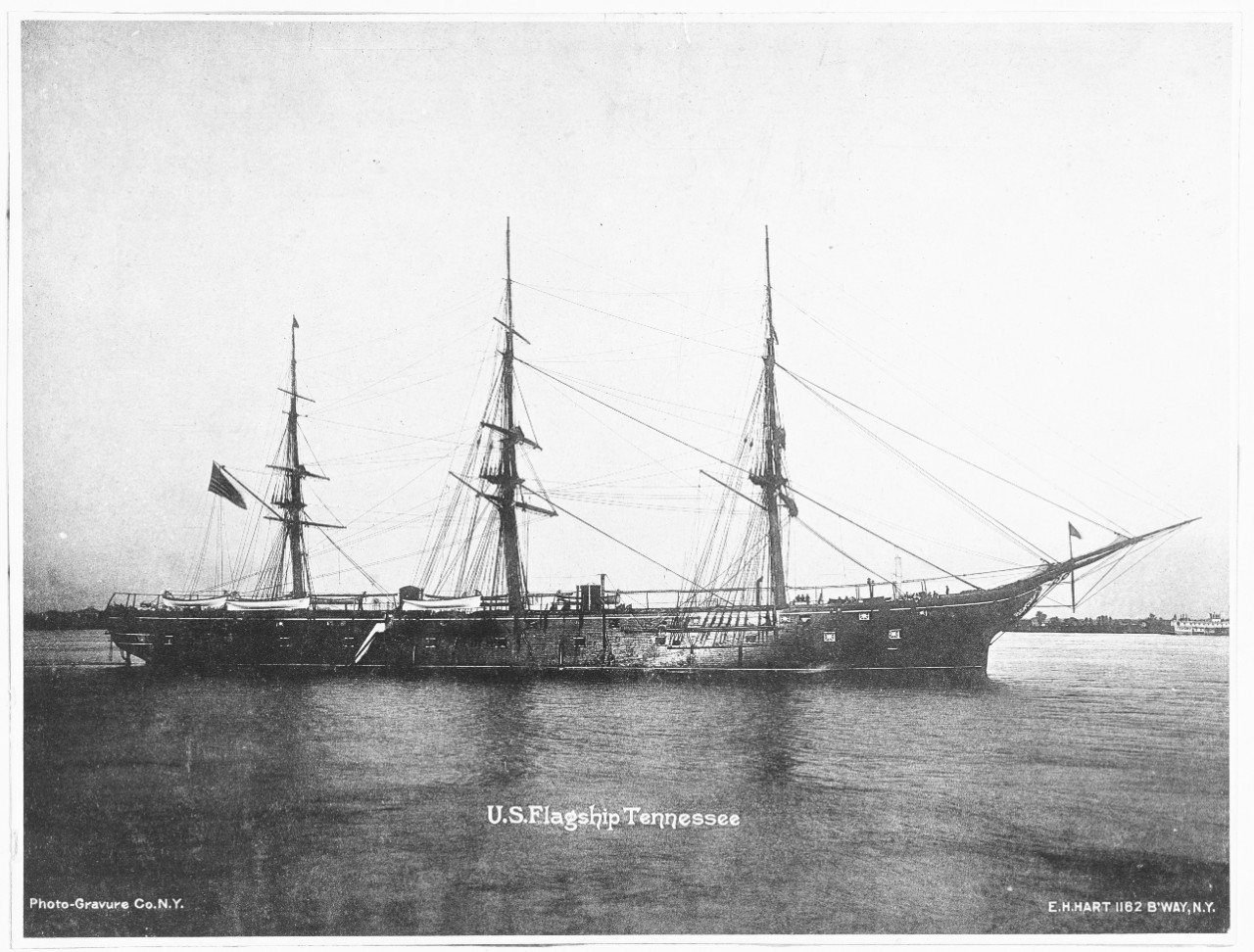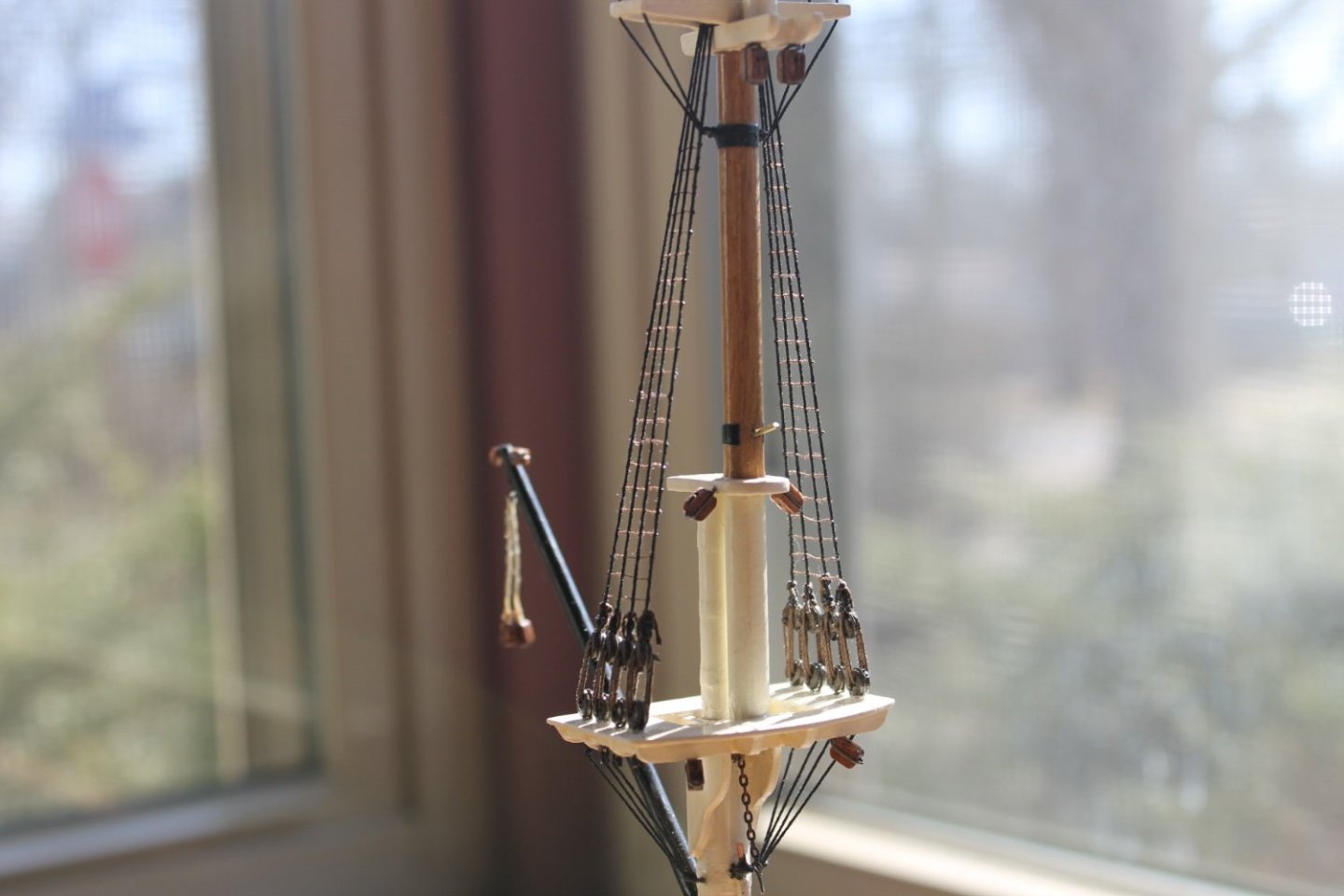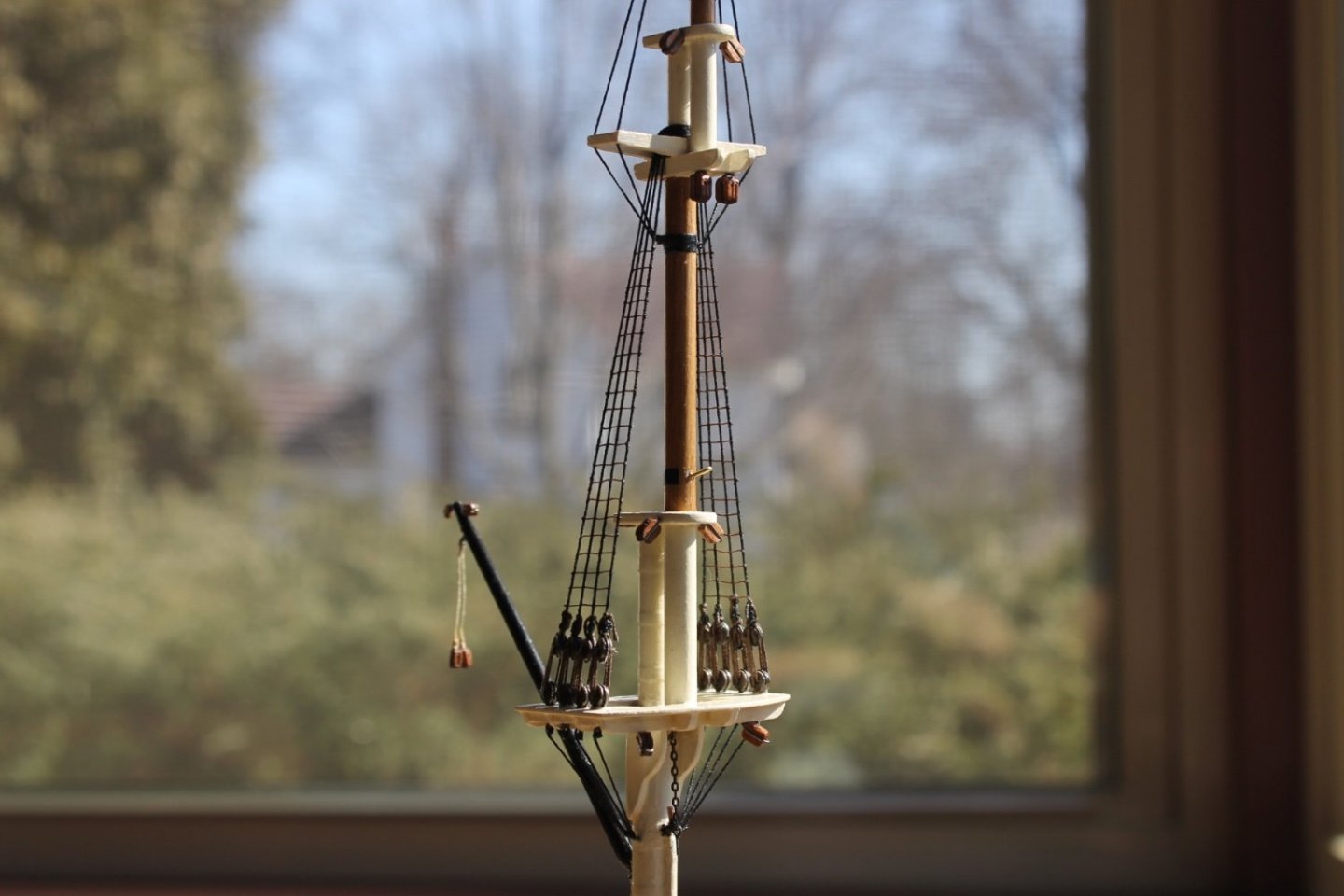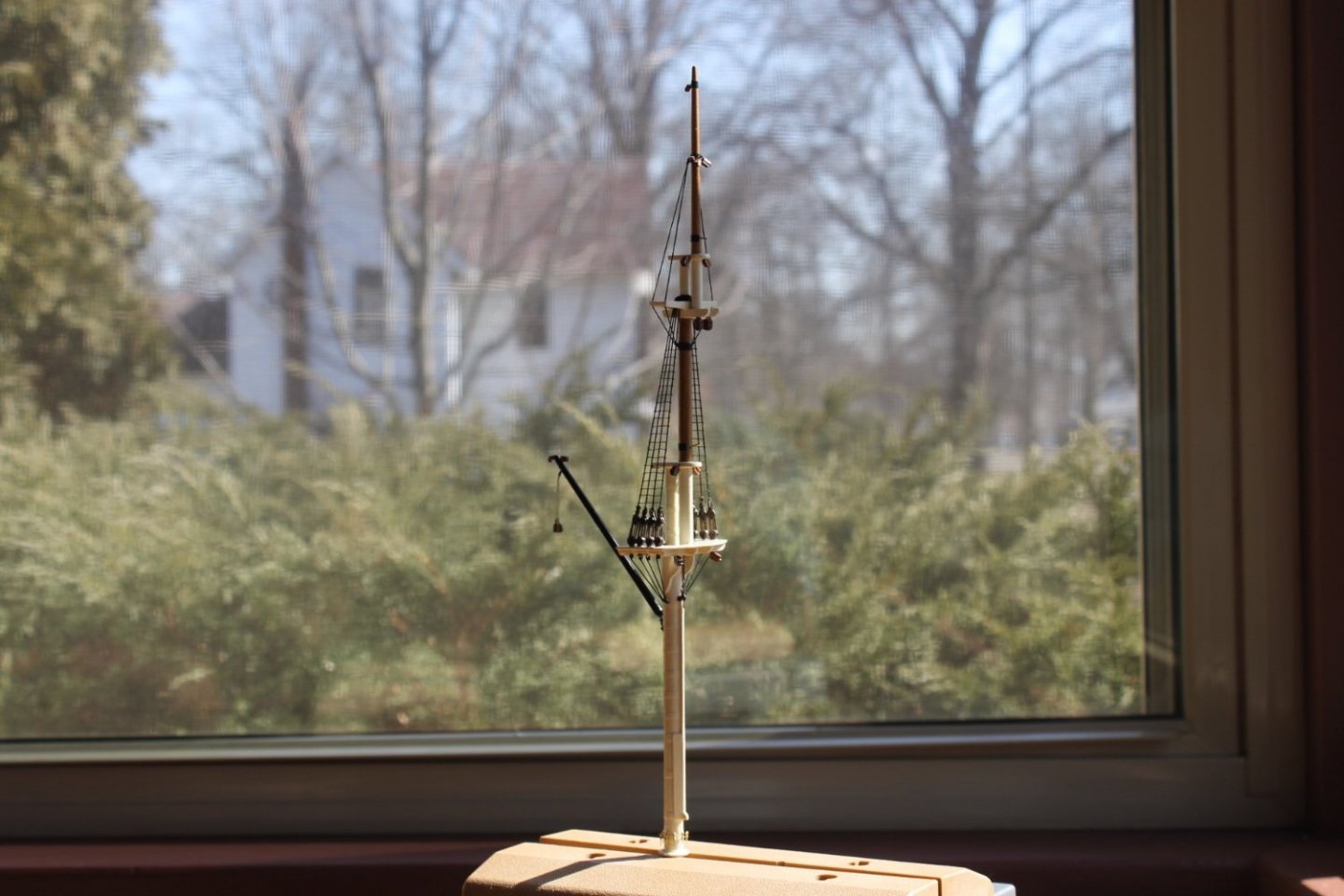-
Posts
6,079 -
Joined
-
Last visited
Content Type
Profiles
Forums
Gallery
Events
Everything posted by Keith Black
-
Welcome to MSW. I look forward to seeing your Santa Maria in a build log.
-
Okay, Glen, I just found your new build log. I've pulled up a chair and have my rum buttered popcorn at the ready. You know, a beer bottle makes a better looking cannon than a rum bottle but dispensing with the internals is a lot less pleasing.
- 177 replies
-
- Independence
- bottle
-
(and 1 more)
Tagged with:
-
Rob, I'll not be adding ratlines to the topgallant shrouds as those seem to have been going out of use around the turn of the 19th century (if memory severs correctly) Petersson's book doesn't show topgallant ratlines and I can't see topgallant ratlines in any of the photos I have of the Tennessee. I'm going for the 'less is more' approach. Brian, Eberhard, Mark, Glen, Keith, Lynn, Gary, and Rob, I'm honored by your approval and thankful to all for the likes. I am truly blessed that each of you is part of my MSW family.
-
Eberhard, more micro detail wizardry. The Wespe is really starting to take shape, how much longer do you think it will take you to complete her?
-
It makes indentations in the tape to mimic nail heads.
- 39 replies
-
- cutty sark
- sergal
-
(and 1 more)
Tagged with:
-
DB, have you considered using copper tape and a pounce wheel? If you MSW search you'll find several discussions regarding same. It makes for a clean look with a lot less work and a heck of a lot cheaper.
- 39 replies
-
- cutty sark
- sergal
-
(and 1 more)
Tagged with:
-
Thank you to everyone for the helpful and supportive comments and to everyone for the likes. The mizzen topsail ratlines are done using the weaving method. I tried using a #15 beading needle to pierce the shroud lines but try as I may, I couldn't thread the needle eye. It would have been far easier to pierce the shroud lines but alas I had to use a #12 needle. I used 0.12 inch spacing representing 14 inches at scale. Sometimes the spacing got wonky but I'm determined to make sure this doesn't happen in the future. All I can say is that it's done and I can move on to rigging the mizzen topgallant and topsail yards before stabbing the mizzen into the deck for it's final time. I'll continue to use the weaving method for the remaining ratlines as I know I can have moderate success using this method. This first attempt may not look topnotch but maybe by the end I'll be able make something a bit more sparkly. Again, thank you to everyone for stopping by and being part of my journey.
-
Gary, while the plug maybe the stepchild in the process, there's craftsmanship in the making. Your typical excellent craftsmanship is evident as are your detailed instructions.
-
Dave, very nice. The stagger looks spot on. I pray you and your wife get well quickly.
- 362 replies
-
- Amati
- Lady Nelson
-
(and 2 more)
Tagged with:
-

New (old) Guy on the Block here.
Keith Black replied to Dearborn's topic in New member Introductions
DB, nice hull, sweet. -

I have adopted another orphaned kit
Keith Black replied to mtdoramike's topic in RC Kits & Scratch building
Good on ya, Mike -
Rob, the last two photos didn't post. Please post them agin, TY.
- 3,560 replies
-
- clipper
- hull model
-
(and 2 more)
Tagged with:
-

New (old) Guy on the Block here.
Keith Black replied to Dearborn's topic in New member Introductions
DB, welcome to MSW. I look forward to seeing photos of your Cutty in a build log. -

Greetings from Amish country Ontario
Keith Black replied to Deacon's topic in New member Introductions
Deacon, welcome to MSW. I look forward to seeing your Victory in a build log. -
SB, welcome to MSW. Please introduce yourself in the new member section, see the link below. I look forward to seeing photos of your father's ship. https://modelshipworld.com/forum/3-new-member-introductions/
-
Marc, I hope you don't mind me posting Eberhard's build log. His technique for painting with inks and washes is pretty incredible. See post #572
- 2,650 replies
-
- heller
- soleil royal
-
(and 9 more)
Tagged with:
-
Steven, I think you'd be better served impregnating the card with CA instead of white glue.
- 740 replies
-
- Tudor
- restoration
-
(and 4 more)
Tagged with:
-
Dave, if you can cut your planks widths to 0.10 inch without issue it would be well worth doing. I don't have the means to do so, I'd have to go with a wider plank out of necessity.
- 362 replies
-
- Amati
- Lady Nelson
-
(and 2 more)
Tagged with:
-
Rob, I understand. I think you or someone who glues ratline to shroud line successfully needs to look over my shoulder and see why I'm not able to manage this seemingly simple process. I know this, if I can't get it done on a test board, in an optimal working position, I'm not going to trust using the method on the mizzen where my angle of attack makes my hands shake more so than when working at the test board. I've got nothing against the method, for you and those who can use it without issue, I applaud you.
-
Dave, in old photos of ship decks you can't/don't see tree nails. I think they're cool but not realistic. At 1:64 one foot = 0.1875 inches. That would make the deck length 10.4331 inches or 55.6 feet at scale. 30' = 5.625", 28' = 5.25", 26' = 4.875", 24' = 4.5", 22' = 4.125", and 20' = 3.75". Adjust plank lengths as required for the plank ends to fall center of the beams which are placed every fourth frame. The plank end pattern should fall on a different beam at least every third plank to spread the load. The problem comes when making the plank widths to scale, 6" = .09375". This is where authenticity and reality/practicality meet. Even making the planks 12" to scale (which they would never be that wide due to cupping) would only make them 0.1875".
- 362 replies
-
- Amati
- Lady Nelson
-
(and 2 more)
Tagged with:
-
Docker, welcome to MSW. I look forward to seeing the l'Ambitieux come to life in your build log.
About us
Modelshipworld - Advancing Ship Modeling through Research
SSL Secured
Your security is important for us so this Website is SSL-Secured
NRG Mailing Address
Nautical Research Guild
237 South Lincoln Street
Westmont IL, 60559-1917
Model Ship World ® and the MSW logo are Registered Trademarks, and belong to the Nautical Research Guild (United States Patent and Trademark Office: No. 6,929,264 & No. 6,929,274, registered Dec. 20, 2022)
Helpful Links
About the NRG
If you enjoy building ship models that are historically accurate as well as beautiful, then The Nautical Research Guild (NRG) is just right for you.
The Guild is a non-profit educational organization whose mission is to “Advance Ship Modeling Through Research”. We provide support to our members in their efforts to raise the quality of their model ships.
The Nautical Research Guild has published our world-renowned quarterly magazine, The Nautical Research Journal, since 1955. The pages of the Journal are full of articles by accomplished ship modelers who show you how they create those exquisite details on their models, and by maritime historians who show you the correct details to build. The Journal is available in both print and digital editions. Go to the NRG web site (www.thenrg.org) to download a complimentary digital copy of the Journal. The NRG also publishes plan sets, books and compilations of back issues of the Journal and the former Ships in Scale and Model Ship Builder magazines.








